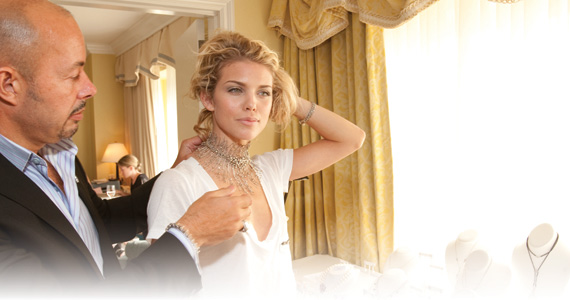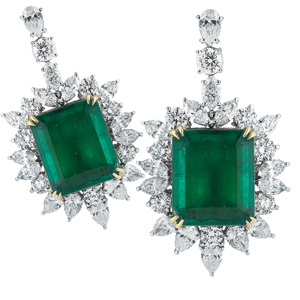|
Cover
The Celebrity Connection
Turn celebrity mania into a marketing opportunity.
By Amber Michelle

|
| At the Golden Globes, Michael O’Connor styles actress AnnaLynne McCord — who plays Naomi on the CW Network’s “90210” — with a platinum and diamond necklace created by Platinum Guild International Japan. |
America is a nation obsessed by celebrities. From television and film actors to royalty and reality stars, their every move enthralls us. We want to know what celebs wear and what they eat, where the glitterati vacation and how they decorate their homes. All of this interest in our favorite A-listers creates a new marketing opportunity for savvy jewelers to get in on the action.
“Celebrity-driven media achieves some of the highest engaged viewership and readership of any other media,” says Michael O’Connor, style expert and president of New York City–based marketing and public relations consulting firm, Style & Substance.
In his presentation “Red Carpet to Retail,” made during the Smart Show in Chicago, O’Connor cited how media content has changed to illustrate our heightened interest in the famous. “One in five ads has a celebrity; 25 years ago, that was nonexistent,” he explains.“Magazine covers are all about celebrities. It used to be supermodels were on the covers. Content used to be how-to, now it is about how a celebrity does it.”
In addition, television networks are expanding celebrity fashion and red-carpet programming. O’Connor cites the following: Red-carpet coverage on average gleans roughly two-thirds of overall awards-show viewers. E! Network’s eight-and-a-half hours of red-carpet run-up to the Oscars had a viewership of 12 million. “Fashion Police,” a television show that used to air only after the awards broadcasts, has expanded to a weekly program. NBC augmented its red-carpet segment at the Golden Globes to 90 minutes and ABC added a fashion broadcast before the Oscars to bring viewers to the network. “The fashion coverage is so profitable and so well viewed that the networks are asking if it is more important than the actual show,” says O’Connor.
Research done by O’Connor through a media placement agency found that celebrity magazines and television shows have a consistently higher audience than other media. Us Weekly has a circulation of 2 million, People magazine has a circulation of 3.6 million and “Entertainment Tonight” has 12 million viewers. This compares to Vogue magazine, with a 1.2 million circulation, Town & Country, with 455,000 in circulation and Harper’s Bazaar, with a circulation base of 734,000.
“Popular culture has become increasingly celebrity focused and marketers are using celebrity to grab reader and viewer attention, engage readers and viewers in content and position and sell products,” notes O’Connor. “High viewership plus the celebrity halo is a marketer’s dream.”
In her article, “The Culture of Celebrity,” published in Psychology Today, Jill Neimark says, “Celebrity in America has always given us an outlet for our imagination, just as the gods and demigods of ancient Greece and Rome once did. Celebrities are our myth bearers, carriers of the divine forces of good, evil, lust and redemption.”
In short, says O’Connor, “Celebrities create aspiration. They lead glamour-filled lives, they have made it — many have rags-to-riches stories, they own status objects and their status is attainable. It was not long ago that we only had movie icons; now, with reality shows, celebrity is more attainable.”
When we see celebrities on the red carpet, their clothes, jewelry, even manicures are being scrutinized and talked about. Celebrities influence and validate our choices, says O’Connor. In agreement is Kim Kitchings, vice president, corporate strategy and program metrics, Cotton Inc., who notes that “in the past decade, more consumers were looking toward stars as fashion inspirations and they take their fashion cues from them.” Cotton Inc. has used a number of famous faces in their television ads touting the benefits of cotton. Currently, Hayden Panettiere, the star of ABC’s “Nashville,” is featured in the ads.
Designers also get a boost from red-carpet mania. “People follow and want what celebrities wear,” comments Just Jules jewelry designer Julie Romanenko. “Celebrity placement has helped me increase my brand awareness and pushed me to explore creating larger pieces with higher price points that have ultimately resulted in sales for my retail customers.”
“Consumers aspire to what celebrities have,” observes O’Connor. “They are receptive to the messaging and implied endorsement that celebrities provide. Celebrities produce the results that marketers desire. Celebrities break through the clutter and engage the reader, they reinforce brand positioning and they inspire the consumer to action.”
The action, of course, is to get consumers into a retail situation where they can buy what the celebrity has. Once the consumer is in the store, Rebecca Foerster, U.S. vice president, Rio Tinto Mining, points out that “celebrity wear give a sales associate an interesting story to relate to a customer to start the sales process.”

|
| Diamond and emerald earrings from Takat were worn by the character Pamela Barnes on the TNT reboot of the series “Dallas.” On the show, the earrings had belonged to Pamela’s aunt and were a gift from her father, Cliff Barnes.
|
All of this fascination with celebrities can be used at retail to boost sales. O’Connor offers the following tips:
- Use celebrity media to show what jewelry the stars are wearing. Post the pictures in your store or on your social media.
- Show a similar look. Celebrities may wear something that not everyone can afford but you can show a similar piece at affordable price points.
- Create visuals and merchandise around a theme. For example, show celebrities wearing earrings and then tell how earrings work with a particular face shape.
- Carry brands that have been worn by celebrities.
- Capitalize on celebrity trends. Show a picture of a celebrity wearing a particular item, such as tassel earrings or rose gold, and then show your versions of those items.
- Stay aware of trends.
Celebrity trends are always changing, but right now, O’Connor cites four major looks that the stars are shooting for.
- Necklaces, worn front or back, like Anne Hathaway and Jennifer Lawrence at the Oscars. Necklaces are versatile; show different ways to wear them, advises O’Connor.
- Blackened metals that create a vintage feel are universally relevant, no matter what the metal. This trend is influenced by an interest in supernatural television shows, such as “Vampire Diaries,” “Once Upon A Time”and “Grimm.” Blackened metals give a piece a Goth vibe, or the look of an amulet.
- Color is everywhere in fashion and jewelry is a good way to introduce color. Colored gemstones are often a good price point for an aspirational piece — a big look at an attractive price.
- Stacking and layering is a way to get customers collecting and coming back into the store, and buying one piece at a time is affordable. Consumers can also mix high-end and lower-price-point jewelry.
- Ultimately, concludes O’Connor, “besides food and shelter, we buy to create self-esteem and belonging. We aspire to certain things such as what celebrities have and then we tailor our purchases to our own situations.”
Article from the Rapaport Magazine - June 2013. To subscribe click here.
|
|